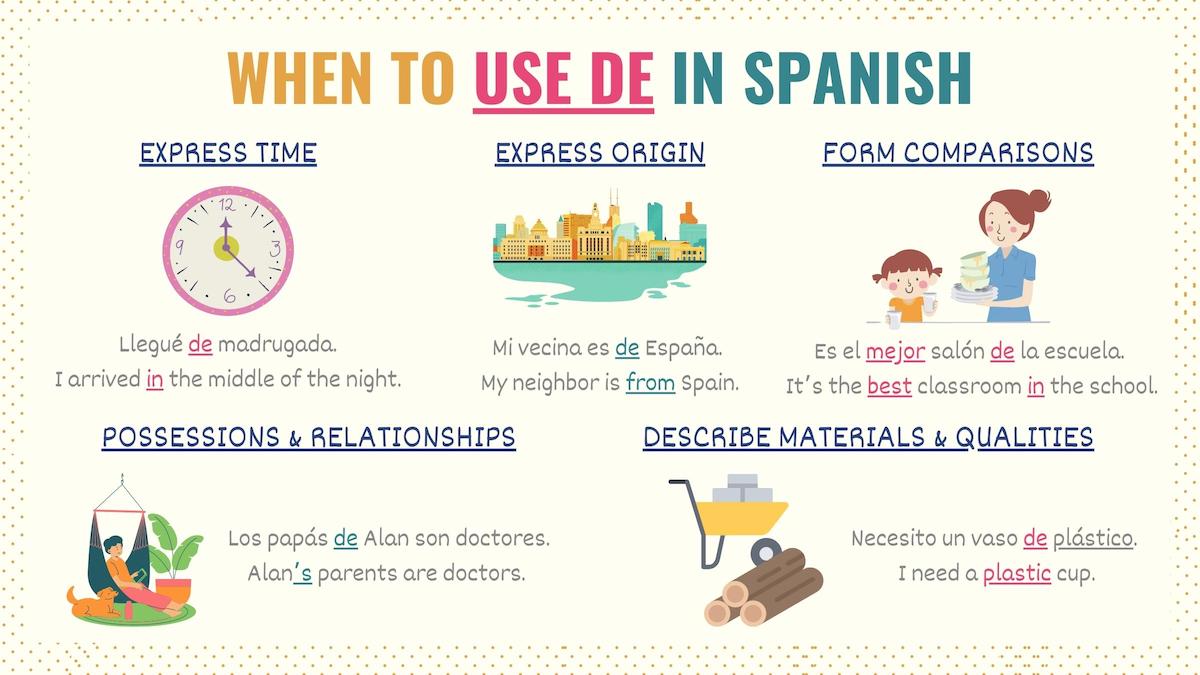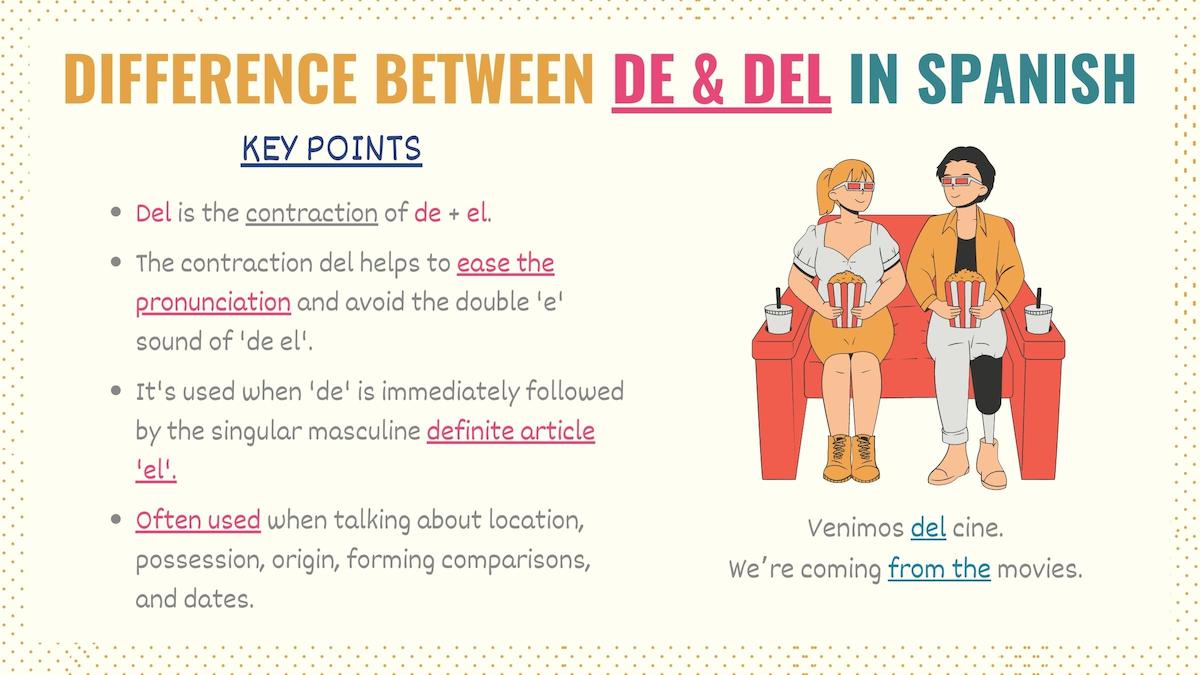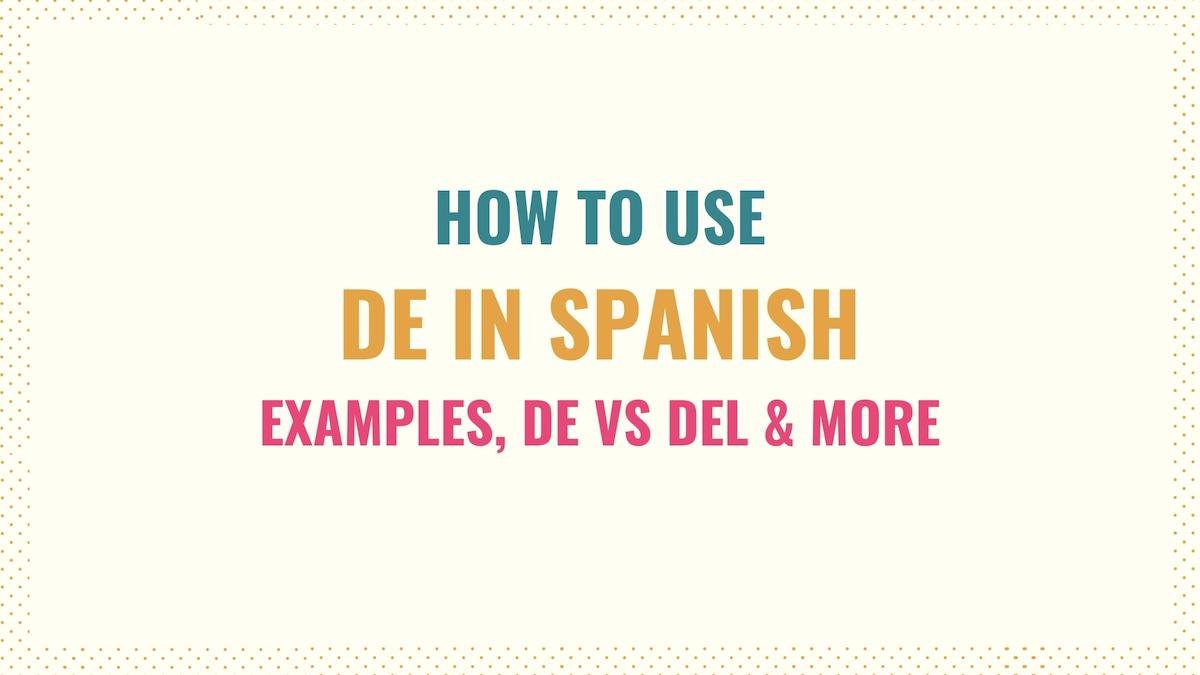De is one of the most frequently used prepositions in Spanish since it allows you to express ownership, relationships, and where someone or something is from, among other things. Seeing that its uses are applied daily, in this guide, you’ll learn how to use de in Spanish.
- How & When to Use De
- De vs Del in Spanish
- Bonus: Common Expressions with De
- Next Steps: Spanish Resources
I’ve included real-life examples that can easily show you how to use this word correctly. Let’s do this.
When to Use De in Spanish?
In Spanish, de is used to:
- Talk about possessions and relationships
- Express origin
- Describe materials and qualities
- Form comparisons
- Express time
Below is a detailed explanation of what structures you must use in each use case.

Express possession or relationships
De in Spanish is often used to talk about people’s belongings and relationships. Note that this use cannot be applied when referring to your own relationships and possessions.
[Noun] + de + [noun]
El carro de Mindy es rojo.
Mindy’s car is red.
Los papás de Alan son doctores.
Alan’s parents are doctors.
Ese muchacho es el novio de mi hermana.
That guy is my sister’s boyfriend.
With this application, it’s common to use Spanish possessive adjectives instead of de.
Express origin
The preposition de also allows you to convey something or someone’s origin. Here are some examples:
[Verb conjugated] + de + [noun]
Vengo del dentista.
I’m coming from the dentist.
Mi vecina es de España.
My neighbor is from Spain.
Los tacos y el tequila son de México.
Tacos and tequila are from Mexico.
Expressing origin not only refers to nationality but also says where a person or thing is coming from. Remember that you can also use Spanish adjectives of nationality to express someone’s origin.
Express what something is made of
The structure de + noun is used to talk about the qualities, portions, material, or style of something:
El vestido de seda es mío.
The silk dress is mine.
Necesito un vaso de plástico.
I need a plastic cup.
Nos gustan las películas de acción.
We like action movies.
Su celular es de color negro.
Her phone is black.
Forming comparisons
As its name suggests, Spanish superlatives allow you to compare things against each other. With these structures, de introduces the group of things against which you’re comparing something.
Es el mejor salón de la escuela.
It’s the best classroom in the school.
Samantha es la más amable de sus hermanas.
Samantha is the kindest of her sisters.
Express time
With certain nouns and adjectives, de in Spanish is used as a time reference point:
Mi hermana llegó de madrugada.
My sister arrived in the middle of the night.
De niña, no me gustaba comer verduras.
As a child, I didn’t like to eat vegetables.
De grande, Luis quiere ser astronauta.
Luis wants to be an astronaut when he’s older.
When it comes to time, this Spanish word also measures when something starts and finishes:
De + [noun/years] + a + [noun/years]
Trabajamos de lunes a viernes.
We work from Monday to Friday.
Carolina se va de viaje del 15 al 20 de mayo.
Carolina is going on a trip from May 15 to May 20.
De vs Del in Spanish
The Spanish word del is the contraction of de + el. This contracted form must be used when the preposition de is followed by the definite article ‘el’, which is used with singular masculine nouns.
Check these examples:
Vengo de la farmacia.
I’m coming from the pharmacy.
Venimos del cine.
We’re coming from the movies.
In Spanish, his contraction is done to ease the pronunciation and avoid having two ‘e’ sounds in a row. In short, del is still the preposition de, but combined with an article.
Some contexts where you can see this contraction more often are expressing location, possession, origin, forming comparisons, and saying dates.

Bonus: Common Expressions with De
In addition to the uses you just learned, this Spanish preposition is also used in some idiomatic expressions. Here is a list of common phrases:
- A pesar de: Despite
- A cambio de: In exchange
- A diferencia de: Unlike
- De acuerdo: Okay / Agreed
- De hecho: In fact
- De modo que: So that / In order that
- De nuevo: Again
- De paso: Passing through / Temporary
- De pies a cabeza: From head to toes
- De repente: Suddenly
- Piel de gallina: Goosebumps
What to Do Next: Related Spanish Resources
Now that you’ve learned how to use de, you should also understand the difference between al and del since these contractions are commonly confused. Although this word can be used to express ownership, you should also know how to use Spanish possessive adjectives.
Like de, there are other common prepositions in Spanish that can help you communicate your ideas more clearly. So, check what those words are and try to start adding them to your conversations.
Download the PDF for De in Spanish
De is a crucial preposition to learn in order to sound natural when speaking Spanish. Download the PDF for this guide with all the use cases, rules, examples and expressions.



